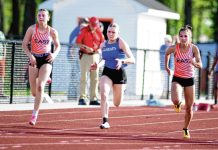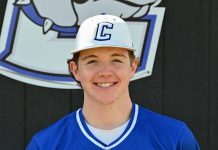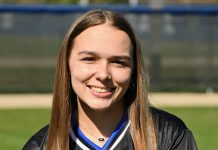The play was a rather innocuous one in Columbus North’s blowout win earlier this month at Southport.
After taking a pass, Amy Weisner headed for the basket. As she drove the lane, she was fouled hard. Still, she made the basket and subsequent free throw for a three-point play.
If Weisner hadn’t been through what she had been through the past five years, the play likely wouldn’t have been a big deal. But for the senior guard, it was another sign she had recovered from a major back injury.
Finding
[sc:text-divider text-divider-title=”Story continues below gallery” ]
the problemWeisner showed plenty of promise as a basketball player her seventh- and eighth-grade years. But during her eighth-grade season, she began to feel pain in her back. Her parents took her to a chiropractor, but X-rays came back negative.“I was able to walk at school, but sitting for long periods of time, it was tough in classes,” Weisner said. “It caused me pain. It was a different kind of pain, but it didn’t hurt as bad. It was something I had to work through with physical therapy.”
Four minutes into her opening freshman game at North, Weisner drove to the basket, got fouled and hit the floor. This time, she knew it was serious.
Dr. Daniel Kraft of Indianapolis diagnosed Weisner with a double pars fracture. She had been playing with the condition since at least the summer before her freshman year.
“We started out with chiropractic care first, thinking it was just maybe something that was out of line or muscular,” said her mother, Dana Weisner. “We did massage and that type of stuff. We went through about five different particular doctors before we figured out what was really wrong with her.”
That February, Amy Weisner underwent surgery. She was told if the surgery didn’t go well, she might not be able to walk again.
“It was really scary,” Amy Weisner said. “The main goal was to be able to walk after surgery, but I was hoping to play basketball again.”
A successful surgery
The surgery, performed by Dr. Rick Sasso in Carmel, took about five hours. But everything went well.“He looked at the X-rays and MRI and knew immediately what the problem was,” said Amy’s father, Mark Weisner. “But until we got in there, and he started doing the surgery, he didn’t realize how serious it was. It actually took about two to three hours longer than anticipated.”Traditionally, the operation on a pars fracture fuses the l5 s1, the lowest motion segment in the lower back. Sasso just fixed the pars fracture and didn’t do the fusing.
“If you can just fix the fracture and keep motion at the lowest motion segment, that’s optimal,” Sasso said. “In the old days, the techniques weren’t very good, but nowadays, the techniques are a lot better in trying to fix that.”
A painful rehab
Following the surgery, Amy Weisner spent two days at St. Vincent Hospital in Indianapolis. Then came the rehabilitation process.Weisner did a couple months of rehab at St. Vincent Sports Performance, then about four months at Columbus Regional Health. She performed a lot of core exercises to regain stability, balance and strength.“It was tough going through them,” Weisner said. “The first month of doing them was pretty sore and painful, but after that, it got better. I could tell it was helping a lot.”
About a month or so after beginning rehab, Weisner realized she would be able to come back and play basketball again. She could shoot the ball, but wasn’t able to participate in competitive practice action for about seven months.
When Weisner returned for her sophomore year, the Bull Dogs had a C team instead of a freshman team because there were so few freshman players. So she started that year on the C team.
Four games into the season, she had played so well that head coach Pat McKee and junior varsity coach Ron Patberg moved her up to the JV.
Making a contribution
Last year, Weisner was a starter for the North JV. She also dressed for the varsity and saw a little action for a team that went 28-1 and captured the Class 4A state title.This season, the 5-foot-7 Weisner is a regular contributor off the bench for a North squad that is 20-1 and ranked No. 1 in the state with a week left before the postseason.
“She’s really smart, and she does what we need her to do, and she understands her role,” McKee said. “She defends, she knows where to be, she has a nose for loose balls. Like anyone, she’d like to play more, but she’s understanding of the circumstances, and she gives us her best effort every time she’s out there.”
McKee said as a sophomore and junior, he’d hold Weisner out of a drill here and there. If her back hurt, she’d tell the coaches, and they would pull her out for part of a day.
This year, Weisner has not once asked out of anything.
“I think kids respect how she plays hard and does her job and knows what she’s doing,” McKee said. “She’s not a rah-rah type kid. She’s kind of quiet, but there’s certainly respect there, and they know that she’s been through a lot just to be here.”
A bright future
Thursday night, Weisner will celebrate Senior Night with fellow seniors Paige Littrell, Elle Williams and Emily Kim, but her basketball career might not be nearing an end. She is considering playing at Indiana University-Kokomo or Centre College (Kentucky) and majoring in business.No matter how this season turns out for the Bull Dogs, Weisner will remember with fondness her career at North.
“It’s awesome,” she said. “I just love being with the girls. I’ve been around them for four years-plus, and it’s great being around them. I have a lot of fun with them.”
[sc:pullout-title pullout-title=”What is a pars fracture?” ][sc:pullout-text-begin]
“Pars” is short for “pars interarticularis,” which is part of the vertebra and can be found between the inferior and superior articular processes of the facet joint.
A pars fracture of the spine is called “spondylolysis.” The condition is usually caused by excessive or repeated strain to pars interarticularis area of the spine and it is sometimes called a pars defect.
Pars fractures are often found in football and volleyball players, gymnasts and cheerleaders, but rarely in basketball players. British heavyweight boxer Anthony Joshua had to postpone his fight against Kevin Johnson last year because of a pars fracture.
Dr. Rick Sasso, who performed surgery on Columbus North senior basketball player Amy Weisner, said pars fractures are seen a lot in athletes, especially in their early teenage years, due to hyperextension in the lower back. The vast majority are treated non-operatively.
Rest and bracing are the typical treatment options for a pars fracture. In more serious cases, such as that of Weisner, surgery may be required.
“A lot of times, if they don’t get better bracing, they hurt so much it’s hard to sit through school,” Sasso said. “So a lot of times, the goals are really low. But our goal is always to get them back to playing their sport and get them back to all their normal activities.”
[sc:pullout-text-end]




